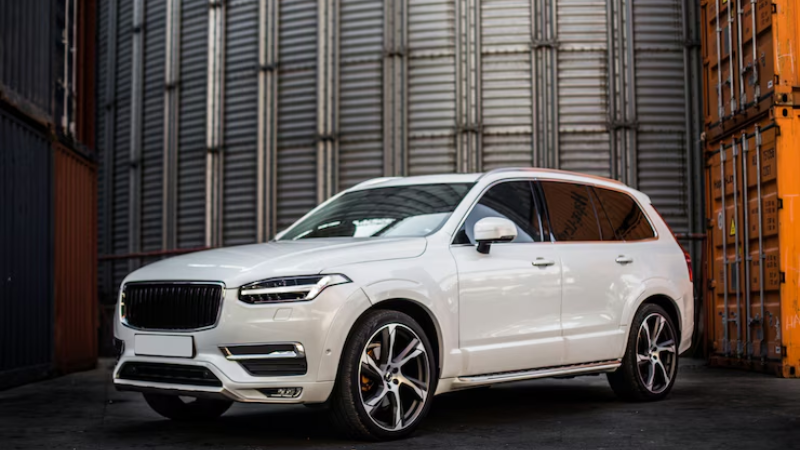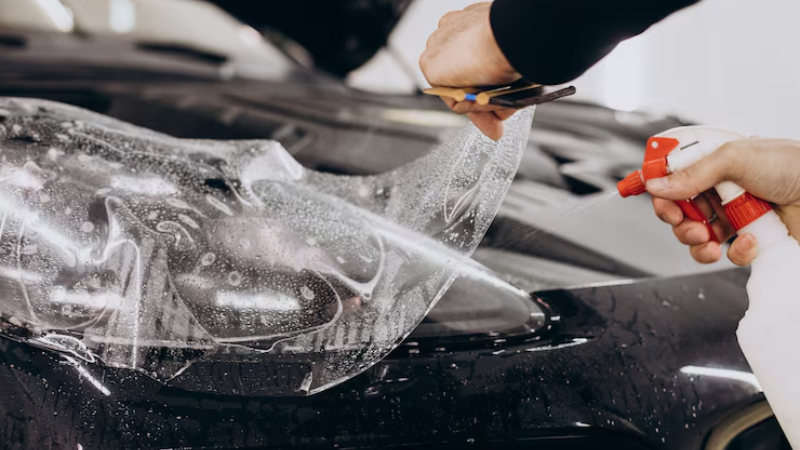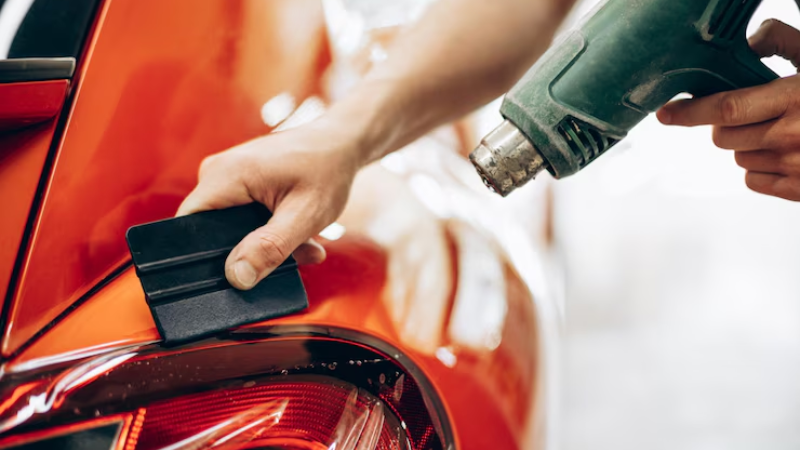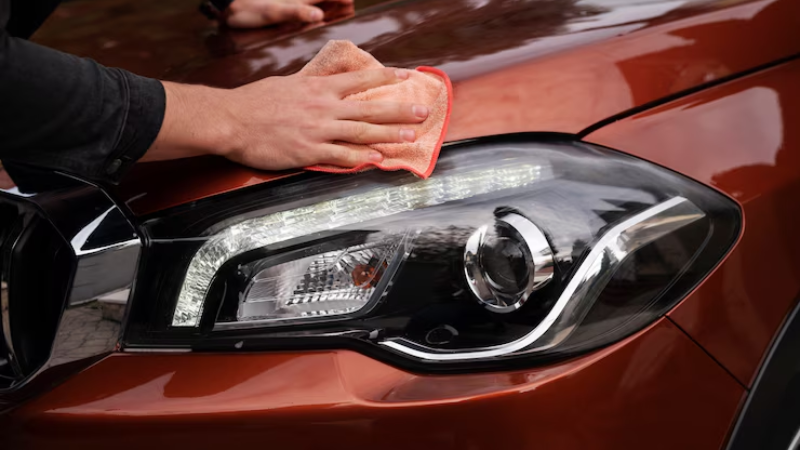Paint Protection Film (PPF) is a durable elastomeric polymer that keeps vehicles flawless and protects their value. Proper application is key to long-lasting results. Carlikefilm’s expertise helps businesses safeguard their fleets and enhance customer trust. This guide explains how PPF works and how to apply it effectively.
What is Paint Protection Film (PPF) and Why So Important?
Paint Protection Film (PPF) is an extremely thin, clear protective covering layer film with an adhesive side and a top-overlying coat on the body of the vehicle. Everyday-use cars and fleets need to provide optimal protection. Adding PPF to your fleet helps you get good ROI and resale value.
Understanding the PPF in the commercial fleet will help you to get more sales and customer satisfaction. You should know that Paint Protection Film is an overcoat that conceals the paint to protect it from chipping, road wear, scratches, and other wear. Let’s see everything you need to know about PPF.

Advantages of PPF
PPF protects the car paint from fading due to UV rays. Let’s look at some other benefits of PPF:
Protection Against Road Grime and Contaminants

PPF creates a protective coat that resists the entire vehicle paint from sticking or getting damaged by road grime, tree sap, rock chips, bird droppings, and other environmental contaminants.
Ceramic coating also provides similar results, but PPF is for a long-term plan. Weigh down your choice between ceramic coat and PPF before applying any.
Resistance Against Light Scratch and Swirl Marks
The finish is liner film, light scratch and swirl mark resistant, maintaining the shine and glossy appearance of the automobile.

Maintenance of Gloss and Shine
PPF maintains the shiny and slick appearance of the car by protecting the paint against regular use, maintaining the freshness and new look of the car in the long term.
Protection against Fade and UV Guard
Where regions experience too much sun exposure, PPF protects against harmful ultraviolet light that may produce paint fade, colour shift, or degradation from years of UV rays exposure.
Road Salt and Harsh Condition Guard
For drivers driving in extreme road salting regions or severe weather conditions, protective paint film provides a straightforward barrier shielding the car surface from corrosive substances, reducing future rust and damage to the surface.

Application of PPF
Below is A Step-by-Step Guide For the DIY Application Process of PPF installation. Make sure to read the complete guide for wrapping the car before starting a DIY process:
Preparation
Initially, wash the car with a soap solution to release it from dust and trash. Next, dry the car to remove water. Now, thin particles on the surface are cleaned with a clay bar. Isopropyl alcohol solution surface wash leaves the surface residue-free. Surface preparation like this ensures good adhesion and a silky finish.

Tools and Materials Needed
To heat the PPF, you will need a heat gun or steamer, a utility knife, microfiber towels, a slip solution spray bottle, and a squeegee. They let it get sprayed and moulded the right way.
Cutting and Putting in the PPF
Trim PPF to the same width as the car panels. Spray sealant solution or adhesive onto the surface of the car and the adhesive face. Place the film over the coated area and begin at the corner, squeegeeing the film smooth.

Work out from there along the panel, dislodging air bubbles and slip solution with heavy overlapping strokes.
Smoothing and Finishing
Wind the film gently with the heat gun and let it dry in its body form. Inspect for faultiness and repair faulty corners. Trim excess film to provide a clean finish.
Drying Time and Aftercare
Let the film cure for 24 to 48 hours after applying PPF. Do not wash the car during this period. This is to enable the film to adhere well to the paint surface. Check regularly the door edges and corners to seal.

Ceramic Coating and PPF
You can topcoat ceramic coating on PPF for added protection. It creates a hydrophobic coating that does not allow water and dirt to adhere to it. Ceramic coating boosts the self-healing property of PPF, along with protecting it from acid rain and UV.
Ceramic coating and PPF combo offers physical as well as chemical protection, adding an extra security to your car body.
Key Considerations for Installing PPF
Paint Protection Film (PPF) installation must be done to deliver performance and durability. Small application errors may lead to cosmetic defects, adhesion loss, or early film failure.

The followings are some of the most important best practices and safety measures to follow to installing paint protection film:
Do Not Overstretch the Film: Overstretching the film will cause it to leave behind adhesive residue. Not only will this produce a messy finish, but it also prevents the film from sticking and sealing the surface effectively.
Do Not Use PPF Under Direct Sun: Direct sunlight quickens adhesive dry time, dries film, and provides an even tougher job for realigning and smoothing out. This increases the possibility of air bubble entrapment and misalignment, which reduces the quality of the end result.
Prevent Blistering Chemical and Abrasive Spray Contact: Contact with harsh chemicals like ammonia or high-pressure water sprays will rupture or crack the film. Contact with power washes or scrubbing cleaners must be avoided to maintain the life of the film.

Properly Precondition the Surface in Advance: Poor preconditioning causes improper bonding during the bonding process and film life. Cleanliness and proper decontamination wash away dirt, oils, or deposits such as calcium carbonate, magnesium salts, or silicate residues, which will prevent bonding.
Use Quality Tools: Heat guns, squeegees, and edge tools are employed in applying the film smoothly and flat over curved surfaces. Proper tools used in the proper way erase bubbles and produce good finishes.
Use Correct Drying and Curing Times: Bubbles, lifting, or deterioration of the bond may be caused if drying or curing time is cut back. Adequate time permits the adhesive to cure properly, thereby ensuring long-term performance.
Avoid Rushing Processes: Attempting to rush to save time to get through any installation can lead to tacky bonds, open seams, or premature film failure. Care and patience at each step are essential to create a professional finish.

Choosing the Right Type of PPF
There are various forms of finishes available in the market. Self-healing or non-self-healing gloss and matte PPF finishes are offered. Gloss offers shine, and matte offers a satin finish. All of these finishes are good for your use, but understanding the PPF coating price will help you select the best.
Self-healing is appropriate for daily driving. Choose a film best suited to your car’s condition and environment. Use weather conditions, UV rating, and road conditions to choose the type of film.
Below is a simple table overview of various options of PPF films, including those suitable for fog lights, so you can choose the most suitable type for your application:
| Type of PPF Film | Key Feature | Best For |
|---|---|---|
| Clear Gloss Film | High shine, invisible protection | Showcasing original paint, luxury cars |
| Matte (Satin) Film | Smooth matte finish, non-glossy look | Unique styling, matte paint jobs |
| Colored or Tinted Film | Adds color or tint + protection | Custom look, color accents |
| Self-Healing Film | Repairs light scratches with heat | High-use areas, daily drivers |
| Hydrophobic Film | Water-repellent, easier cleaning | Rainy climates reduce water spots |
| Extra-Thick Film | Added impact and chip resistance | Off-road vehicles, trucks, and heavy use areas |
PPF vs. Professional Installation
What’s Best for You? Let’s learn.
DIY Installation

DIY installation is inexpensive but labor and requires skill and patience. It’s best suited for customers who do DIY work.
Professional Installation
Professional installation provides a smooth finish. Professional installers possess the education and equipment to handle complex curves and finishing. While expensive, it minimizes failure risk and includes service warranties. For luxury or high-end vehicles, professional installation may be worth it.
Make sure to go through the cost of wrapping a car on both for installation, i.e., DIY and by a professional, before making any choice.
Tips for Cleaning and Maintaining Your PPF
To maintain your Paint Protection Film (PPF) in its brand-new, original condition, a few best practices, such as a clay bar treatment, are necessary. Certain habits are good enough to give the film a sense of newness and long-term performance.

Here are some maintenance tips to take care of your PPF:
Use Mild Car Wash Products
Always wash your car using mild, pH-neutral car wash shampoos that contain isopropyl alcohol. Heavy scrubbing cleaners or those with scrubbing agents or heavy-duty degreasers will remove the exposed self-healing side of PPF.
Do Not Use Abrasive Scrubbers or Tools
Never employ abrasive scrubbers, brushes, or sponges on PPF. They will dull or scratch the self-repair coating, diminishing its ability to cure minor scratches and gloss finish.

Allow Minor Scratches to Heal Naturally
Self-healing PPF is designed to repair minor surface scratches over time, especially when the vehicle is left in sunlight or low heat. Don’t attempt to “correct” small imperfections too soon — they will correct themselves naturally.
Dry with Microfiber Cloths
Dry your vehicle only with clean, soft microfiber towels. These prevent swirl marks and cushion the surface from too much friction that can wear down the film over time.
Limit Automatic Car Wash Use
Some automatic car washes are technologically safe, but constant use will break down the seams or edges of the PPF. Hand washing is best, but if a car wash must be used, choose one that does not have abrasive brushes or high-pressure drying systems.

Avoid High-Pressure Sprayers Near Your Vehicle
Pressure washers can be utilized to clean, but not have the nozzle touch film or seams and edges, since it will dislodge the film or rupture adhesion.
Treatment with PPF-Safe Sealant or Coating
You may also treat with a water solution along with PPF-specific sealant or ceramic coating as a further precaution. It may enhance hydrophobicity, become easier to clean, and extend the lifespan of the film.
Regular Checks

Check your PPF regularly for lifting edges, bubbling, or uneven wear. Catching small problems early can avoid expensive repairs or replacement down the line.
FAQs
Q1: What is the Lifespan of PPF?
All high-grade PPF materials have a lifespan of 5 to 10 years, depending on the company, outside world exposure, and maintenance cycles. Keeping it clean at regular intervals and using no abrasive chemicals will ensure it lasts longer.
Q2: Can we remove PPF without damaging the paint?
Yes, PPF can be installed professionally with no damage to the vehicle’s original paint and safely. It can be removed with the right tools, but skill, care, and heat are employed so no paint is damaged and no adhesive residue is left on the vehicle.
Q3: Is PPF a good investment for an old or used vehicle?
Yes, and if auto paint is in the first instance in proper shape, PPF can even be used for preservation and protection from further harm. Any such pre-existing paint flaws should be repaired before application to gain maximum advantage.
Conclusion
PPF Installation is the ultimate solution to safeguard your vehicle’s finish against nature and physical wear and tear. DIYers and fleets can get their money’s worth with a wonderful PPF product that is paint life extension, cosmetic redoing, and resale protection of used cars.
Maximize Your Fleet’s Protection with Carlike’s PPF
Carlikefilm offers the highest-quality PPF for individual vehicles and fleets. Our films are engineered for easy installation, long-lasting durability, and flawless finishes.
We also offer car wrap vinyl, window tint films, and decorative vinyl for your business to stand out in the competition.
Call us now at our B2B department and allow us to create for you.



